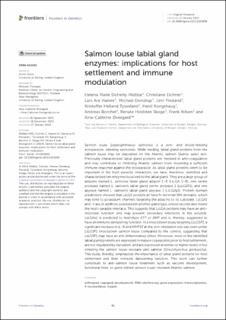| dc.description.abstract | Salmon louse (Lepeophtheirus salmonis) is a skin- and blood-feeding ectoparasite, infesting salmonids. While feeding, labial gland proteins from the salmon louse may be deposited on the Atlantic salmon (Salmo salar) skin. Previously characterized labial gland proteins are involved in anti-coagulation and may contribute to inhibiting Atlantic salmon from mounting a sufficient immune response against the ectoparasite. As labial gland proteins seem to be important in the host–parasite interaction, we have, therefore, identified and characterized ten enzymes localized to the labial gland. They are a large group of astacins named L. salmonis labial gland astacin 1–8 (LsLGA 1–8), one serine protease named L. salmonis labial gland serine protease 1 (LsLGSP1), and one apyrase named L. salmonis labial gland apyrase 1 (LsLGAp1). Protein domain predictions showed that LsLGA proteins all have N-terminal ShK domains, which may bind to potassium channels targeting the astacins to its substrate. LsLGA1 and -4 are, in addition, expressed in another gland type, whose secrete also meets the host–parasite interface. This suggests that LsLGA proteins may have an anti-microbial function and may prevent secondary infections in the wounds. LsLGAp1 is predicted to hydrolyze ATP or AMP and is, thereby, suggested to have an immune dampening function. In a knockdown study targeting LsLGSP1, a significant increase in IL-8 and MMP13 at the skin infestation site was seen under LsLGSP1 knockdown salmon louse compared to the control, suggesting that LsLGSP1 may have an anti-inflammatory effect. Moreover, most of the identified labial gland proteins are expressed in mature copepodids prior to host settlement, are not regulated by starvation, and are expressed at similar or higher levels in lice infesting the salmon louse-resistant pink salmon (Oncorhynchus gorbuscha). This study, thereby, emphasizes the importance of labial gland proteins for host settlement and their immune dampening function. This work can further contribute to anti-salmon louse treatment such as vaccine development, functional feed, or gene-edited salmon louse-resistant Atlantic salmon. | en_US |

